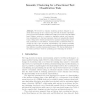Free Online Productivity Tools
i2Speak
i2Symbol
i2OCR
iTex2Img
iWeb2Print
iWeb2Shot
i2Type
iPdf2Split
iPdf2Merge
i2Bopomofo
i2Arabic
i2Style
i2Image
i2PDF
iLatex2Rtf
Sci2ools
CICLING
2009
Springer
2009
Springer
Semantic Clustering for a Functional Text Classification Task
Abstract. We describe a semantic clustering method designed to address shortcomings in the common bag-of-words document representation for functional semantic classification tasks. The method uses WordNetbased distance metrics to construct a similarity matrix, and expectation maximization to find and represent clusters of semantically-related terms. Using these clusters as features for machine learning helps maintain performance across distinct, domain-specific vocabularies while reducing the size of the document representation. We present promising results along these lines, and evaluate several algorithms and parameters that influence machine learning performance. We discuss limitations of the study and future work for optimizing and evaluating the method.
CICLING 2009 | Machine Learning Performance | Natural Language Processing | Semantic Classification Tasks | Semantic Clustering Method |
Related Content
| Added | 24 Nov 2009 |
| Updated | 24 Nov 2009 |
| Type | Conference |
| Year | 2009 |
| Where | CICLING |
| Authors | Thomas Lippincott, Rebecca J. Passonneau |
Comments (0)

